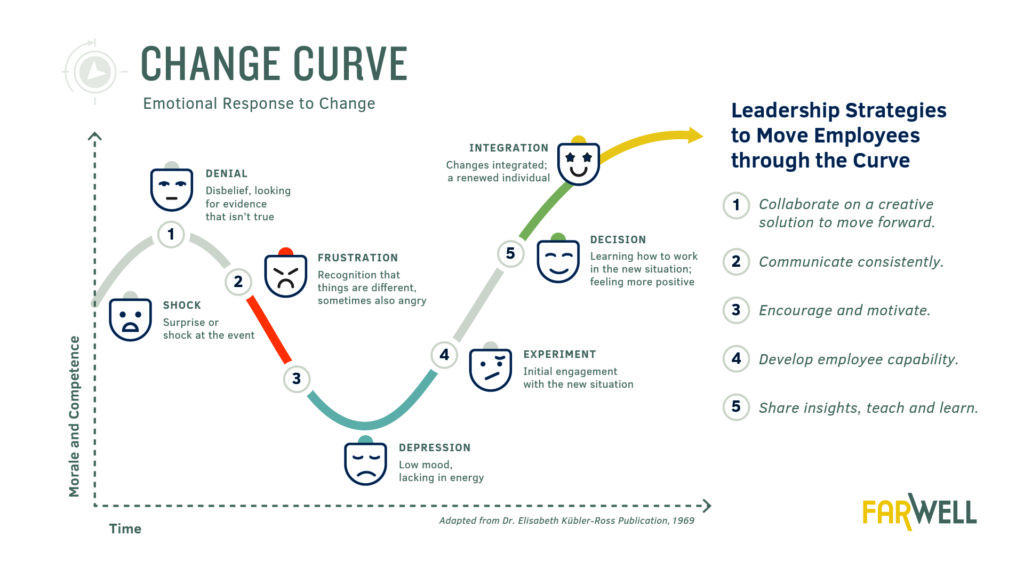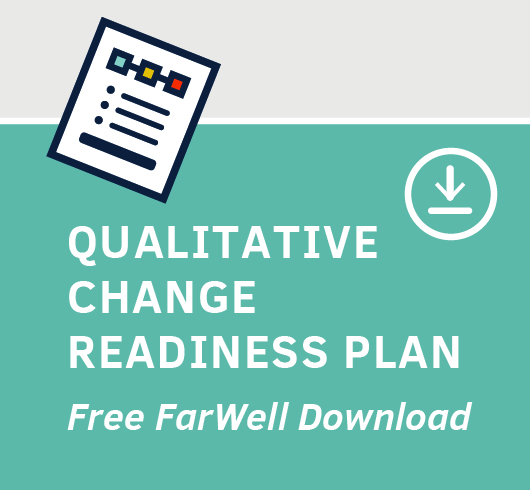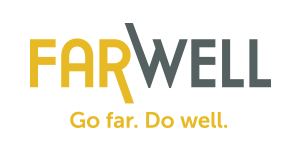Discover advisor articles and other FarWell resources.
Go far. Do well. Call (800) 987-2015
Change Readiness | How to Prepare Your Organization for New Priorities and Goals

Business Process Tasklist for Teams Experiencing Downtime
April 27, 2020
Leading and Managing Remote Teams Webinar: What We’ve Learned, What We’ve Proven, and How to Lead in the New World
May 14, 2020Executive leaders often have to make disruptive, large-scale business changes to be more profitable, competitive, and in today’s environment, possibly even survive. There may be no period in history where that would apply more than during a global pandemic. Many organizations analyze how those business changes impact processes and technology but overlook how they impact their people.
Without a clear understanding of what’s changing for them, employees experience lack of confidence, fear and frustration resulting in low levels of employee adoption of the changes. These experiences lead to increased risk of failure to achieve the goals of the change. Beyond simply revising processes or implementing new systems, successful change is dependent on the people who are impacted and their readiness for change.
What is Change Readiness?
Change readiness is the measurement of employee and stakeholder confidence to successfully adopt and sustain a change.
Rachel Breitbach, FarWell Senior Advisor
Key Steps to Improve Change Readiness and Adoption in an Organization Before Leading a Change Initiative:
Leaders who focus on change readiness lay a critical foundation toward successful implementation. By incorporating these three key steps of change readiness, organizations build their resilience and ensure their organizations achieve their aggressive goals in today’s disruptive and competitive landscape.
- Include change readiness in overall change planning
- Measure change readiness
- Analyze change readiness risks and take appropriate actions

Step 1 – Include Change Readiness in Overall Change Planning
Many organizations fail to consider change readiness when implementing changes. Leaders engage stakeholders, send communications and conduct training yet do not measure whether those efforts have sufficiently prepared their organization for the change.
Complete Comprehensive Change Readiness Assessment Surveys
Even when leadership includes readiness in change planning, readiness assessments may be incomplete. For example, organizations may only send surveys to assess training delivery. These surveys highlight whether the employees understood the training content and that the instructor provided it at an adequate pace. But this assessment doesn’t provide an opportunity for those impacted by the change to share whether or not they feel adequately prepared to adopt the upcoming changes and where to go for support. Those topics should also be included in any change readiness assessment.
Define a Formal Change Readiness Plan with Leadership
Without incorporating a formal change readiness plan, leaders don’t understand why employees may be frustrated or anxious about an organizational change. For example, employees can feel they don’t have the awareness, knowledge or skills to perform in the expected new way of working. Knowing this in advance of the change, allows leaders to proactively address these gaps in their change strategies.
Develop a Change Readiness Experience Map for Impacted Employees
Change readiness assessments map out how impacted employees feel about the change at any given time.
Use a Modified Kübler-Ross Change Curve Tool to Gauge Employee Experience Insights
One tool FarWell advisors share includes a modified Kübler-Ross Change Curve. This curve shows how an individual may move through change.
The insights gained from learning where employees fall on the curve can then influence change strategies moving forward. Adoption of organization-wide change is more likely when change managers focus effort on moving people through the change curve.


Step 2 – Measure Change Readiness
To give leadership a complete picture of how ready an organization or a specific group of employees may be for a change, conduct change readiness assessments that include both quantitative and qualitative data measurement. The measurements can also be tied to the change initiative’s or organization’s Key Performance Indicators (KPIs).
Quantitative Change Readiness Data Options:
- Financial – Can we afford the change? (i.e. How much budget is available?)
- Human Resources – Are we appropriately staffed to handle the change? What resources are needed at what capacity and for how long to get through a normal learning curve? What resources (internal and external) are needed to provide support to those going through the change and for how long?
- Service Levels – What controls are in place to ensure service expectations remain at acceptable levels? (e.g. customer satisfaction, quality, response times, etc.)
Qualitative Change Readiness Data Options (Subjective Feedback):
For qualitative change readiness, include those leading the change as well as those directly impacted by the change – employees, partners and customers – as part of the data collection to ensure all stakeholder groups are represented. Ask them about their understanding of the change, what they need to do differently, possible barriers and how they feel about the new ways of working.
It is typically more difficult to gather sufficient qualitative data so recommend using numerous methods for collection such as:
- Online surveys
- Guided focus groups
- Employee interviews
Communicate a Complete Picture: Combine Qualitative and Quantitative Change Readiness Data
Quantitative data is relatively straight-forward. Qualitative data is more subjective in nature, making a group consensus more challenging to capture and communicate. Include both for a complete picture of change readiness and plan to continue tracking the data as the team moves through the change.

Step 3 – Analyze Change Readiness Risks and Take Appropriate Action
Change readiness data and feedback can dramatically alter a project’s approach. Leaders and key stakeholders need to know where their employees are in respect to adopting the change to make project decisions. If employees do not feel ready to adopt the change, then there is a risk that the change will fail and not meet its intended goals.
Leaders Review Change Readiness Risks and Make Course Correction Decisions
Once change readiness assessments are conducted and summarized, leaders have many options and decisions to make. They need to decide whether to cancel, postpone or modify the change initiative if the lack of adoption poses a large enough risk based on the change readiness assessments.
Customer Story: See How Change Readiness Data Reduced Risk and Improved Adoption of A New Procurement System
A project at a global company took a readiness survey a couple of weeks before launching a new global procurement system. The survey results showed that impacted employees understood the reasons for the change and a desire to want to change.
What Readiness Risks Change Managers Flagged for Leaders
However, the results also reflected a high level of fear and anxiety in impacted employees. Employees expressed concern that they would not remember the training provided to perform a process using a new procurement system after implementation.
How Leaders Responded to Flagged Readiness Risks
In response to the readiness feedback, leaders took the following actions:
- To reduce anxiety so employees could have specific individual questions answered, additional open house opportunities were added for employees in the weeks prior to launch
- To reduce fear that they would not remember the training, impacted employees were reminded where to find quick reference job aids and training materials
- To address both the fear and anxiety by ensuring they had appropriate support, subject matter experts (SMEs) were made available in each area for employees to ask questions at launch and for a few weeks following launch
These actions reduced employee fear and anxiety. Subsequent readiness survey results indicated impacted employees felt better prepared to adopt the change. Ultimately, in part due to leadership’s response to readiness survey feedback, the change met its intended outcomes of using the new tool which achieved less purchase orders overall and increased governance over the process.
Download a FarWell Qualitative Change Readiness Plan

Need a quick guide on how to assess readiness, manage risk and course correct before implementing organizational changes? Download a sample FarWell Qualitative Change Readiness Plan Sample (PDF) for change managers, project managers or leaders of change to apply a change readiness practice in your organization. The plan includes FarWell feedback tools, recommendations and step-by-step actions to start measuring change readiness today.




